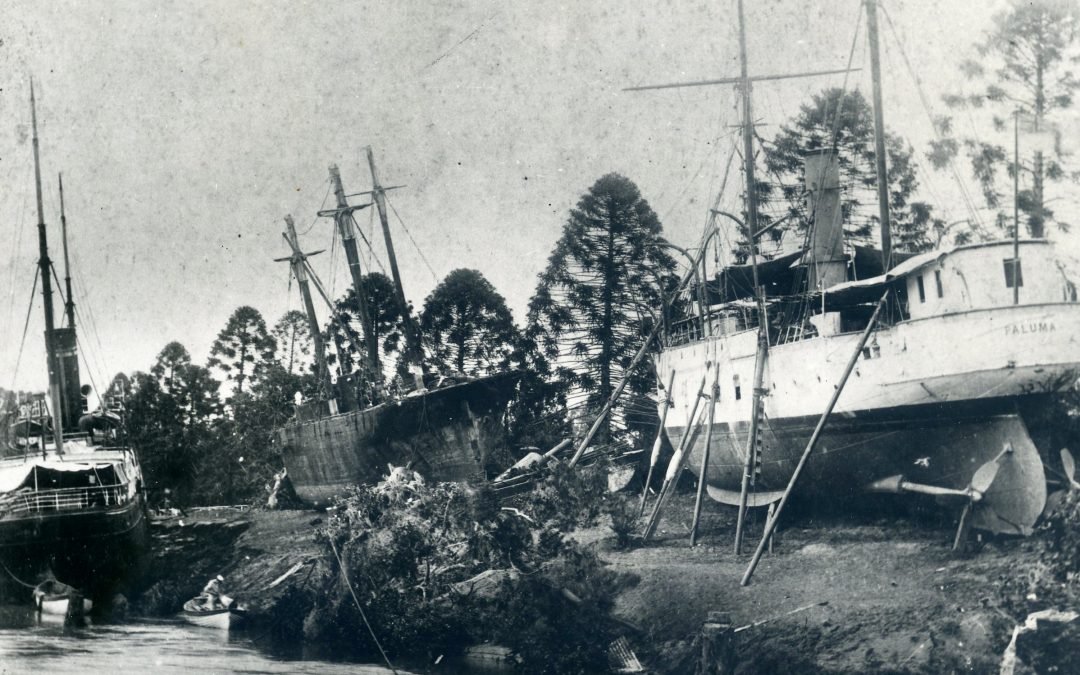The Brisbane Floods of 1893
Timber houses, many with residents clinging onto them, floated down the Brisbane River, bridges collapsed, huge ships were stranded in the Botanic Gardens, and barrels of beer floated through the streets.
That was Brisbane 130 years ago, during the disastrous floods of February 1893.
Nowadays residents of Brisbane continue their love-hate affair with their river with many still struggling to recover from recent floods as history repeats itself.
But 2022 was minor compared with the Great Flood of 1893, really a series of three floods which almost meant the end for the young colony.
In the wake of the floods, the Bulletin reported: “A month ago Brisbane was the most utterly bankrupt and poverty-stricken of all Australian capitals. Now its condition is akin to that of China in a year of famine.”
It all began late in January 1893 when the first of three cyclones hit Queensland in a triple whammy, resulting in three peaks in the river in one month.
The waters rose slowly at first, the lower parts of the city going under and merchants in the CBD began moving stock to higher ground.
Then unprecedented downpours in the upper catchment caused a surge in the river. Large parts of the city were invaded and streets were like canals. Newspapers colourfully described the scene as “the worst inundation since the biblical deluge”.
But even Noah couldn’t have saved the “live animals and plentiful snakes” that swept by, nor the terrified kitten spotted on a piece of furniture headed to the sea.
Tragically journalists reported seeing families clinging to the roofs of their homes crying for help as they swept past helpless onlookers.
According to newspaper reports, 500 houses swept down the river in just one day.
The Indooroopilly rail bridge was destroyed when efforts to save it by anchoring it with a fully laden train failed. It was hastily shunted off the bridge in the nick of time.
Downstream the Victoria Bridge was receiving a battering despite the best efforts of the city engineer and his assistants to clear the debris.
The Telegraph reported: “House after house came rushing down the stream and was dashed against the structure, and cries of horror broke from the excited onlookers.”
A big barn filled with hay hit the bridge, along with furniture, fencing, trees, and “hunks of land like miniature islands”.
It was a losing battle…the bridge “succumbed to the huge heap of debris and the terrific rush of water.”
After a brief reprieve, flood waters returned less than a week later followed by another major peak a few days later.
Many sought solace as barrels of beer floated away from flooded breweries.
The Brisbane Courier noted: “A great deal of drunkenness was unfortunately observable in various directions. Men were seen drinking all they could and then quarrelling for possession of the cask containing the balance.”
Fortunately three ships stranded in the Botanic Gardens after the first flood refloated naturally in the floodwaters that followed.
That classic photo of the grounded ships is one of many documenting the flood to be found in the Royal Historical Society of Queensland archives.
By the end of “Black February” up to one-third of Brisbane’s population of 90,000 was left homeless. Every public structure was turned into a refuge.
Newspapers reported the unofficial death toll at 35, but the actual number of victims was unknown because many were washed out to sea or buried in a grave of silt.
Whole estates had been cleared of houses, on the southside especially, and thousands were homeless. “Most of South Brisbane has altogether vanished,” reports said.
The city was coated in foul-smelling mud, there was no gas, water or power, and “hundreds of looters were out picking over the wreckage of smashed houses.”
The clean-up marked the beginning of the debate that continues to this day…how to spare the city from this ever happening again.
Article by Lynda Scott

